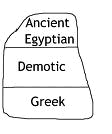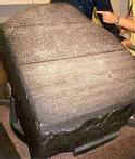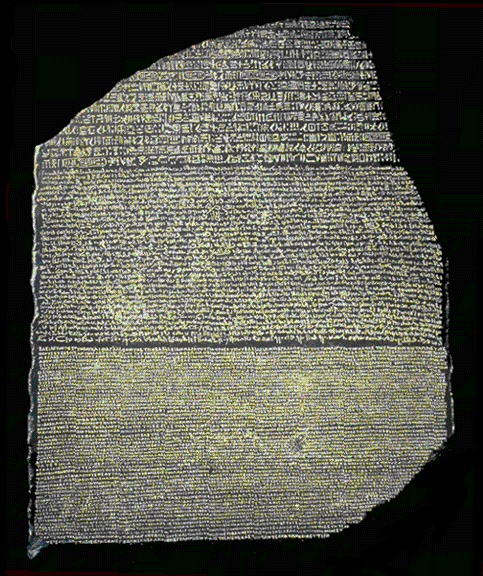Champollion and the Rosetta Stone
Born in France in 1790, Jean Francois Champollion saw Egyptian hieroglyphs for the first time in 1801 at the age of eleven. He was told that no one knew how to decipher them yet. He made up his mind at that time that he would do it.
Fortunately, as it turned out, Champollion was not only a persistent fellow, he was also brilliant. By age 18 he had learned 12 languages, including Coptic, Hebrew, Arabic, Syriac, Chaldean, Chinese, Ethiopic, Sanskrit, Zend, Pahlevi, and Persian. The most important of these was Coptic, for it was the language of Egypt that was derived from ancient Egyptian.
In 1799 – when Champollion was just nine years old– Napoleon Bonaparte of France was trying to conquer all of Europe. Napoleon’s army was in Egypt. Archaeologists and scientists traveled with the army because Napoleon was fascinated by Egyptian history. French troops happened upon a stone tablet that had a lot of writing on it. It was found in the town of Rosetta and therefore called “the Rosetta Stone.” It had writing in Greek, in Demotic (a later Egyptian writing) and also in hieroglyphs. Scholars went crazy with excitement. It was hoped that the Rosetta Stone would be the key to unlocking the texts of hieroglyphs. But it proved much harder than was hoped to crack the code.


Everyone was sure that the stone was saying the same thing in all three languages. The Greek could be translated and so it was thought that this would open up understanding for the rest. Next, the Demotic was translated. But still the hieroglyphs remained a mystery. Scholars knew that it said the same thing as the Greek and Demotic, but what they needed was a system for interpreting each symbol in order for that knowledge to be used to translate other hieroglyphs.
Finally, a man named Thomas Young figured out that whenever a Pharaoh’s name was written in hieroglyphs, it was always inscribed inside a rectangle with rounded corners – what the French dubbed a “cartouche” (that’s just French for cartridge). Now Champollion took that information and focused on the cartouche. Pharaoh Ptolemy’s name was in the Greek script 5 times and, just as predicted, there were 5 cartouches in the hieroglyphs. Champollion knew each one must represent Ptolemy’s name. At last he had a small group of letters to work on and he knew what they spelled. He just had to figure out which symbol went with which sound in the Egyptian language. (If ancient Egyptians had not put their pharaohs names in cartouches, we might still not know anything about the ancient Egyptians.)
Even still the work was daunting. Ancient Egyptian turned out to be a highly complex language with complicated grammar and syntax (languages always simplify over time, so this ancient one was very difficult). Also, the writing system was not just one symbol for one sound in the alphabet, but rather literally hundreds of hieroglyphs which sometimes stood for sounds, sometimes for objects, and sometimes for abstract ideas. Some hieroglyphs were there just to tell the reader how to read the hieroglyph beside it! And Egyptian could be read up, down, or back and forth from either direction. Champollion had to figure out, for example, that the hieroglyph pictures always faced the the direction in which the text should be read. No wonder other scholars had bogged down and given up!
At last Champollion had a major breakthrough. One morning in his study he finally deciphered some symbols with enough certainty to read the cartouche. He reportedly ran to find his brother who was working in a nearby library. Flushed with excitement he flung his papers onto his brother’s desk and cried, “Je tiens l’affaire! Je tiens l’affaire! (I’ve got it! I’ve got it!) and then promptly fell to the floor in a faint.
Because of Champollion’s genius, the world of ancient Egyptian writing is open to scholars everywhere and we now know a great deal about the life and times of the ancient Egyptians, one of the most fascinating cultures in all of history.

The Rosetta Stone <https://blog.britishmuseum.org/everything-you-ever-wanted-to-know-about-the-rosetta-stone/>
